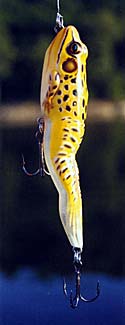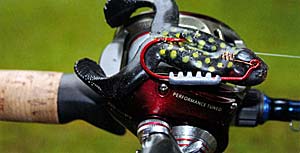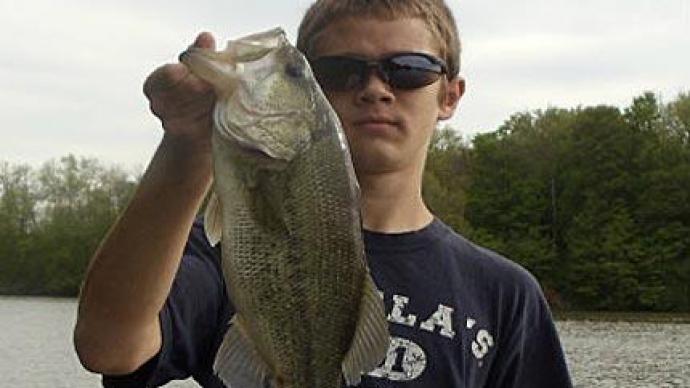
It's no real surprise that lures resembling frogs and toads catch fish. Small ponds and lakes provide frogs with shelter, food, a place to reproduce and raise their young. Although lures that resemble frogs will catch bass almost any time of the year, summer and fall are prime times to be fishing with amphibian-shaped lures. As water temperature rises, bass begin prowling the shoreline, laydowns, docks, mats, and vegetated areas searching for forage like frogs. On the other hand, frogs are always wary of predators whenever they go in or near the water. There's a fine line between swimming across the pond or sitting on matted vegetation and being inhaled by a bass.
Lures that imitate frogs come in several styles, sizes, and shapes. They come in one of the following types: hollow-bodied, soft body, or hard body. Floating hollow-bodied frogs have a narrow shape closely imitating the real thing. Embedded inside is a weight molded into the body and a specially designed double frog hook. Depending on the brand, each bait will have some frog-imitating legs. They are made from living rubber, solid rubber, or silicone skirting. Hollow-bodied frogs can be walked on the surface like walk-the-dog movement with a Zara Spook, hopped, or skipped across the surface. They are highly effective for catching fish out of thick mats, open water, or sparse grass.
Unlike hollow body frogs, soft body frogs are solid pieces of plastic. These baits closely emulate a real frog with legs that look like they are swimming when reeled in. Most will have a belly slot to increase the hookup ratio. No hook is included with solid-bodied frog, but numerous hook manufacturers offer frog hooks in an assortment of styles and sizes. Soft plastic-bodied frogs are designed to be cast out and be reeled on the surface or waked just below. Unlike a hollow-bodied frog, the solid ones will sink when paused. A soft plastic-bodied frog can be fished over thick grass mats, sparse patches of grass, stumps, logs, or any cover. Soft plastic-bodied frogs are usually rigged texposed-meaning the hook is Texas rigged with the tip of the point tucked just under the surface of the lure. A texposed solid body frog is completely weedless and snag-proof.
One other type is the hard body frog constructed from plastic or wood. Hard-bodied frogs have a solid body closely resembling a frog; some of the new hard body frogs are so anatomically accurate it's hard to believe. While some of these hard body frogs are short and stubby, others have a shape similar to a Zara Spook and can walk-the-dog effortlessly with continuous twitches of the rod tip. Hard-bodied frogs can be fished in open water situations or around the edge of grass mats, laydowns, shorelines, submerged timber, and docks.
Almost every fishing pond has productive areas for casting a frog-style lure near the shoreline or within casting distance. Selecting the right style and color of frog is essential. Anglers should focus on grass mats, individual clumps of grass, submerged timber, laydowns, docks, and shorelines. Select lure color based on two important things...native species of frogs and a color that contrasts with the water to be most easily seen by a bass.

Aquatic Vegetation
Almost any type of rooted aquatic vegetation in a pond becomes an oasis for bass. It offers shelter and, more importantly, ambush points. Rooted plants that seem attractive to bass have a recognizable long, flexible yet firm stem similar to water lilies. Free-floating plants have roots hanging beneath them to gather nutrients and not attach to the bottom. Submersed plants like milfoil or pondweed grow underwater, and some produce flowers on the surface. Emergent plants are commonly found in shallow water or near the shoreline. Cattails or bulrushes are examples of emergent plants. Although it's unnecessary to know the scientific name of every plant growing in the pond you are fishing, it is essential to recognize which type of aquatic vegetation you are catching bass on that day. Bass may move from one type of aquatic vegetation to another depending on the time of day, season, angling pressure, and water temperature.
Laydowns and Artificial Fish Attractors
Laydowns and artificial fish attractors are typically found near shallow water, where bass often go to feed on frogs and other forage. These habitat elements offer bass shelter from other predators and provide an ambush point. An individual laydown can hold several bass, while a large artificial fish attractor may have a whole school.
Docks
Docks provide shelter, shade, and an ambush point, but there is usually only one dock on each pond, unlike laydowns. Docks may have brush piles, PVC fish attractors, deep water, or other cover and structure nearby, making it the perfect home for a bass.
Shoreline
One of the most obvious places to fish a frog is next to the shoreline. Not all shores will have bass on them. The season, time of day, food availability, angling pressure, and water temperature will motivate bass to move accordingly. One key to finding a good bank to fish is checking the water depth. Good banks always seem to have a drop-off close by for bass to escape if necessary quickly.
Color and Size Matters
Strangely enough, color and size do matter when fishing a frog. Change your frog's color patterns, types, or size if you are not getting a bite. In general, anglers should fish with smaller frogs in ponds to get more strikes or in ponds that only have small bass. In ponds or small lakes with big bass, anglers should not limit themselves to smaller baits. The old saying is big baits catch big fish. That's true.
As for what color pattern, that's harder to select than size because of the wide selection available. Some color patterns are so lifelike it's hard to believe they're not alive. Other color patterns are wild and don't resemble anything alive but still catch bass. Most anglers like to fish natural color patterns on bright sunny days and darker colors like black, green, and brown on cloudy days or early and late in the day. The color frog you choose may also hinge on water color, just like picking any other bait, especially plastics.
Frog Gear
One of the most important parts of fishing with a frog is the gear. Rod and reels and line size and type are important. The right gear will let an angler reel in a big bass from thick mats or around brush piles. A fishing rod for frog fishing should have a medium-action fast-tip with a stiff backbone. The stiff backbone gives anglers the power to pull the bass quickly from thick cover while controlling the fish. A medium-action fast tip allows an angler to make better and longer pinpoint casts and make it easier to walk the dog. A reel for frog fishing should have a high-speed gear ratio and high-quality drag to turn the bass since they often dive down after the hook is set.
What fishing line you use for frog fishing comes down to each angler. The braid fishing line has its advantages over monofilament or fluorocarbon line. It's stronger, floats, have little stretch, and will cut through the grass. Anglers fishing with braid often rig up with 60- to 80-pound test because it has the same diameter of 10- to 12-pound test monofilament. Braid is typically tied directly to the frog or hook without a leader using a Palomar knot.

Setting the Hook and Landing Fish
Imagine the water's calm surface exploding as a bass violently swings its head back and forth with your frog in its mouth. That's what a frog bite looks like, and few anglers can resist setting the hook too fast when this happens. Every good frog angler has their own method of waiting until the bass has taken the frog deep enough to set the hook. If you do it too quickly, the frog will merely pop out. I once knew an angler who counted to three before setting the hook, which worked for him. The key is to wait until you feel the bass trying to crush the frog in its mouth. Once you feel that, lean back and set the hook hard.
Landing bass out of cover requires just one thing for the angler to do. Keep the head up and moving towards the boat or yourself. If the bass can get deep into cover, it's all over for you, allowing the line to tangle.
The next time you go down to the lake, don't forget to take your frogs. You can fish them from shore or in a boat around all that cover in the pond. There is no more fun bass fishing excitement than watching a bass as it explodes all over a frog and knowing you are about to do battle with such a majestic creature in its environment.
Just remember to count to three.
Reprinted with permission from Pond Boss Magazine




